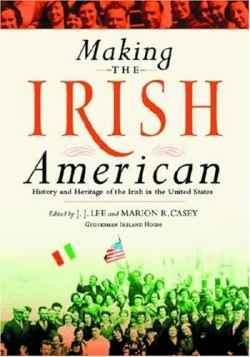Making the Irish American
History and Heritage of the Irish in the United States
Once a year in America, everyone is Irish. No other heritage is embraced so completely as the Irish are on St. Patrick’s Day; no other US ethnic group holds a nationwide annual celebration. The unique identity of the Irish in America is explored in this weighty, thoroughly researched yet easy-to-read volume, which discusses the creative tension experienced by immigrants and their descendants—the tension between becoming American and remaining Irish.
The editors have gathered essays from the likes of Calvin Trillin, the late Senator Daniel Patrick Moynihan, history specialists David Noel Doyle and Kerby Miller, and novelist Peter Quinn. Editor Lee directs the Glucksman Ireland House, a publishing division of NYU Press, is professor of Irish studies and history at NYU, and wrote an award-winning book called Ireland 1912—1985: Politics and Society as well as this book’s elegant Introduction. Casey is adjunct professor of Irish studies at NYU and co-editor of The Irish Experience in New York City; she contributes two essays here.
The book begins with the modestly titled “Modern Ireland: An Introductory Survey,” in which Eileen Reilly relates the history of the Emerald Isle, beginning with the invasion of the Norman Earls of Kildare in the twelfth century. By the mid-1500s, the lord deputies were concentrated in the “fortified hinterland around Dublin … known as the English Pale.” Everything beyond the Pale was discredited, “chiefly with accusations of degeneracy,” thus beginning the English denigration of the Irish. Reilly zips through various oppressive measures (like the anti-Catholic penal laws) and numerous undaunted uprisings; she touches on the Famine with surprising benevolence toward Trevelyan; dispassionately summarizes the Easter Rising and the ascent of the Sinn Féin; and carefully brings the reader up to date with an explanation of the 1998 Good Friday Agreement. Although these details are unknown to most Irish Americans, they provide essential historical infrastructure and emotional backdrop for the exploration to follow.
The subsequent essays address subjects like religion, race, violence, communal loyalties, and anti-Irish sentiment. Others discuss the Scots and Irish, the role of Ulster Irish, and American-Irish nationalism. In Casey’s treatise “Refractive History,” she traces the story of the Irish-founded Emigrant Savings Bank, an institution that “embodies all of the types of memory—individual, collective, popular, and historical.”
Women’s roles are vitally important; Irish immigrants encompass “a much higher female proportion than the European average,” according to Margaret Lynch-Brennan in “Ubiquitous Bridget.” She speaks eloquently to the plight of young Irish women (derogatorily nicknamed “Bridget” or “Biddy”) who “flocked to the United States, where the demand for servants exceeded the supply.” At first elated to learn that they did not need a “fortune,” or dowry, in order to marry, they soon found themselves working exhausting fourteen-hour days, and treated with disdain and mistrust by their employers and society. Most left service as soon as possible, to marry Irish men. “Irish mothers pushed their children to Americanize,” writes Lynch-Brennan, “but not at the expense of their Catholic religion, or by wholly abandoning their Irishness.”
That Irishness found its outlet in music, dance, sports, and politics. Mick Moloney’s lively essay “Irish-American Popular Music” offers a lilting history of the art, from “the invented Ireland of Tin Pan Alley” through the Clancy Brothers and Tommy Makem to the recent innovations of urban rock. Casey’s essay “Before Riverdance: A Brief History of Irish Step Dancing in America” names the famous teachers and different governing bodies of the world competitive Irish dance, and explains the feiseanna, festivals at which step dancers compete. Irish Americans also have excelled in sports, from the fierceness of the prizefighting ring to the poetry of baseball.
Of course, it was through service in New York’s police forces and fire brigades that the Irish worked their way from “no Irish need apply” to the power of Tammany Hall, and eventually to installing an Irish Catholic in the White House. Moynihan writes: “Instead of letting politics transform them, the Irish transformed politics, establishing a political system […] like the social system of an Irish village writ large.”
The only element missing might be a treatment of the native Irish language, currently experiencing revival both in Ireland and certain American cities. The short chapter on Irish-American writers doesn’t do justice to the Irish way with words. One hopes the editors will someday create a book that addresses the language, literature, and poetry of Irish Americans as exhaustively as this one takes on their history. To “bridge the gap … between the general reader and the student,” Lee and Casey have painstakingly compiled recommendations for further reading; however, most will find this book alone as satisfying as a plate of praties or an endearing tin-whistle tune.
Reviewed by
Karen McCarthy
Disclosure: This article is not an endorsement, but a review. The publisher of this book provided free copies of the book to have their book reviewed by a professional reviewer. No fee was paid by the publisher for this review. Foreword Reviews only recommends books that we love. Foreword Magazine, Inc. is disclosing this in accordance with the Federal Trade Commission’s 16 CFR, Part 255.

